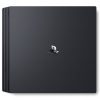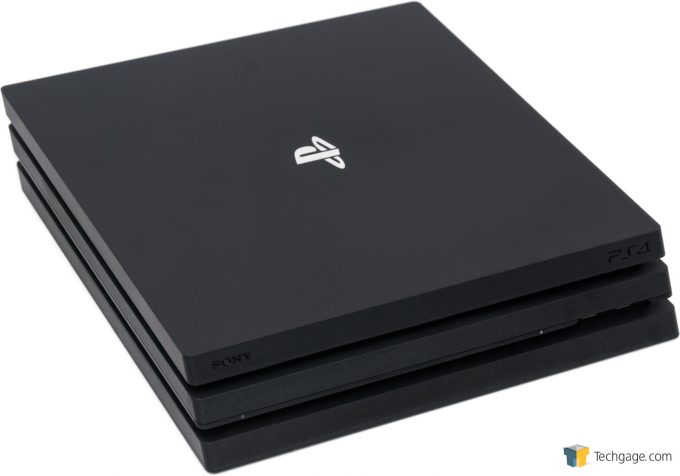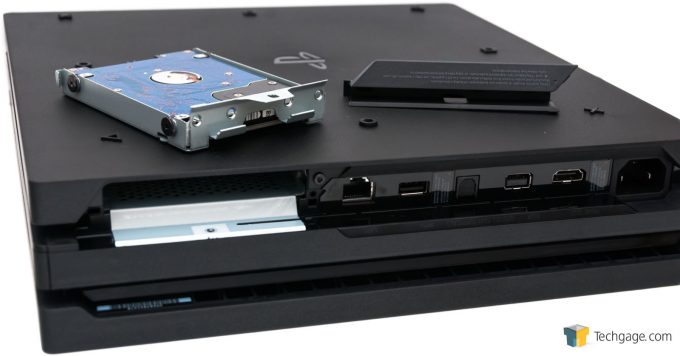- Qualcomm Launches Snapdragon 4 Gen 2 Mobile Platform
- AMD Launches Ryzen PRO 7000 Series Mobile & Desktop Platform
- Intel Launches Sleek Single-Slot Arc Pro A60 Workstation Graphics Card
- NVIDIA Announces Latest Ada Lovelace Additions: GeForce RTX 4060 Ti & RTX 4060
- Maxon Redshift With AMD Radeon GPU Rendering Support Now Available
Sony’s PlayStation 4 Pro: System Performance & HDD vs. SSD Testing

We’ve been taking an in-depth look at Sony’s PS4 Pro over the course of the past week, and now we wrap things up with a technical and performance look. Is the Pro that much faster than the non-Pro outside of gaming? What happens when the hard drive is replaced with an SSD? These questions and more are answered within.
Page 1 – Introduction, HDD vs. SSD & Upgrading PS4 Pro’s HDD
Over the course of the past week, we’ve posted a look at PS4 Pro launch title support and the debates of 60 vs. 30 FPS and 1080p vs. 4K, as well as our full review of Sony’s latest console.
Now? It’s time to wrap up our coverage with a look at the more technical bits of the PS4; namely, performance in comparison to the original release.
In going into this article, I felt like testing would be a breeze. After all, I benchmark GPUs, CPUs, and other PC components all of the time; how hard could it be to benchmark a console? Well, I found out that it is quite hard, only because of the limited control we’re all given over the console.
We can’t control what might happen in the background, so benchmarking one test twice in a row might yield very different results. While most often, I can get away with just 2 runs of a benchmark on the PC, some test results here required more than that to help establish what I felt were accurate results, or at least, better averages.
But, here’s the thing: some of the results might not be the best they could be. The PS4 platform as a whole just doesn’t deliver the same constant performance. I’m not talking about gaming performance, but rather load times; one test run might be 1 minute, and a second run might be 1 minute 10 seconds. It’s the nature of the beast, I suppose. What it does make me feel is that the two results could easily be flipped; they’re that close – it’s all dependent on what the console decides to do at a particular moment.
That all said, the aim of this article is to show performance gains that can be enjoyed by the Pro, outside of gaming (as I do not have the capability to monitor that, and we already have an idea of what gaming performance can be like). So, load times it is, as well as some temperature testing, and also USB copy testing.
For good measure, both the original PS4 and the Pro were tested with their stock hard drives as well as an after-market SSD, to highlight potential improvements when moving away from mechanical storage.
Alright, there’s a lot to cover, so without further ado, let’s get this show on the road.
PS4 vs. PS4 Pro Tech Specs
This article serves as a light technical look at the PS4 Pro, so if you’re more interested in the platform as a whole, I’d recommend checking out our review, which is where I snagged the table below from.
As mentioned in that aforementioned article, the Pro offers a CPU that’s 31% faster, a GPU that’s 227% faster, and memory bandwidth about 24% better. While the new Slim features ac wireless, the original launch model (and its first iteration) did not. USB has also been given a standards bump, as has Bluetooth. Versus the non-Pro, the Pro offers the benefit of a third USB port, as well as Optical out.
| PS4 Slim | PS4 Pro | |
| Product code | CUH-2000 series | CUH-7000 series |
| CPU | x86-64 AMD “Jaguar”, 8 cores 1.6GHz 2x2MB L2 Cache 102.4 GFLOPS |
x86-64 AMD “Jaguar”, 8 cores 2.1GHz 2x2MB L2 Cache 134.4 GFLOPS |
| GPU | AMD Radeon based graphics 1152 Cores 800MHz 1843 GFLOPS |
AMD Radeon based graphics 2304 Cores 911MHz 4197 GFLOPS |
| Memory | GDDR5 8GB 176GB/s |
GDDR5 8GB 218GB/s 1GB RAM dedicated to OS |
| Storage | 500GB, 1TB | 1TB |
| Mass | Approx. 2.1 kg | Approx. 3.3 kg |
| BD/ DVD drive (read only) |
BD × 6 CAV DVD × 8 CAV |
BD × 6 CAV DVD × 8 CAV |
| Input/ Output | USB 3.1 Gen1 port × 2 AUX port × 1 |
USB 3.1 Gen.1 port × 3 AUX port × 1 |
| Networking | Gigabit Ethernet IEEE 802.11 a/b/g/n/ac Bluetooth v4.0 |
Gigabit Ethernet IEEE 802.11 a/b/g/n/ac Bluetooth 4.0 (LE) |
| Power | AC 100-240V, 50/60Hz | AC 100V-240V, 50/60Hz |
| Power consumption | Max. 165W | Max. 310W |
| Operating Temperature | 5 ºC – 35ºC | 5ºC – 35ºC |
| AV output | HDMI out port (HDR output supported) | HDMI out port (supports 4K/HDR) DIGITAL OUT (OPTICAL) port |
| Price | $299.99 | $399.99 |
In layman’s terms, the Pro is more than twice as powerful on the graphics front, which means if games were throttled to 30 FPS on the original unit, it should be possible to achieve 60 FPS on the Pro. However, most developers have been aiming for 4K/30 over 1080p/60, which is a little disappointing.
It’s something that could change over the long-run, as I’m sure no developer wanted to rush out a patch for a weird iterative console like this. Going forward, Pro support will be built in from the start, rather than patched on after-the-fact.
If you have a 4K or HDR TV, the Pro was made for you. Does that mean you should upgrade? Reading our review should help you draw that conclusion. For most, I’d wager that waiting would be the best option: upgrade when there’s a real reason to. If you’re someone who skipped over the PS4 up to this point, I’d highly recommend choosing the Pro over the Slim for the sake of future-proofing.
HDD vs. SSD & SATA 2.0 vs. 3.0
Leading up to the launch of the Pro, a common misconception I saw floating throughout the Web is that the simple upgrade to SATA 3.0 (over 2.0 on the non-Pro) could make differences in load times. While SATA 3.0 offers some nice benefits, those benefits are bound to be nonexistent on the Pro, thanks to other limiting hardware. That includes the CPU, but more than that, a mechanical hard drive simply isn’t going to exhibit a real benefit when moving from 2.0 to 3.0.
That said, if speed improvements can be seen between HDD vs. HDD on non-Pro and Pro, it’s highly unlikely that the SATA port has much to do with it. Instead, it’s much more likely that the Pro’s boosted CPU speed is responsible. That means that a Pro equipped with an SSD could prove more beneficial than a non-Pro with SSD, but ultimately, the differences should be so small that they simply wouldn’t be noticed. The biggest bottleneck at this point, where load-times are concerned, is the CPU.
For the sake of performance-testing for this article, I benchmarked the original PS4 with its stock hard drive, a 500GB HGST model spec’d at 5400 RPM; the PS4 Pro, with its upgraded 1TB model (same series); and also an SSD from Kingston. I should note that SSDs have the tendency to decrease their performance over time, so the benchmarks below do not represent a brand-new SSD – this is an SSD I’ve been using throughout many of our test systems over the past year, so it’s well-used.
To gauge peak performance for each drive, I connected them to one of our PC test platforms and used HD Tune to give us some results. If you’re unfamiliar with SSDs, these results tell all:
| PS4 HDD | PS4 Pro HDD | Kingston SSD | |
| Read Throughput | 75.2 MB/s | 88.1 MB/s | 293.1 MB/s |
| Write Throughput | 73.6 MB/s | 87.1 MB/s | 250.5 MB/s |
| Read IOPS (4K) | 58 IOPS | 61 IOPS | 7036 IOPS |
| Write IOPS (4K) | 122 IOPS | 124 IOPS | 6701 IOPS |
| Read Latency | 17.2 ms | 16.8 ms | 0.145 ms |
| PS4 HDD: HGST HTS545050A7E680 (500GB; 5400 RPM); PS4 Pro HDD: HGST HTS541010A9E680 (1TB; 5400 RPM); SSD: Kingston HyperX 3K SH103S3480G (480GB) |
|||
Overall, this modest SSD proves about 3x faster on the throughput front, although that doesn’t matter too much here, as I can’t imagine a situation where you’re playing a game that will require such massive bandwidth. Instead, what truly matters is the number of operations-per-second each drive can muster (IOPS).
In the case of this SSD, it can handle about 115x more operations per second than the Pro’s hard drive. That’s impressive, but again, that number is much higher than it “needs” to be to see speed improvements. Instead, what’s truly important is the latency: it takes the SSD 0.86% of the time (versus the Pro’s HDD) to begin fetching a piece of data (of which there could be hundreds of pieces in the course of a game’s level load).
All those factors combined make using an SSD a no-brainer, as long as 1) You don’t mind having more limited space, or 2) You have a fat wallet. 500GB SSDs sell for about $125, whereas 1TB models bump that to about double (as you’d expect).
I am not about to suggest to anyone that an SSD is the best choice, because it isn’t. Some people need huge storage, and if that’s the case, SSDs are just too expensive. For me personally, a 500GB SSD serves my needs just fine, as I don’t have that many games installed at once, and because I spend most of my time playing Destiny, the benefits of an SSD there are just too good to ignore (as we’ll see later).
Whether you want to upgrade to an SSD or a faster HDD, just how hard is it? You might be surprised to learn that it’s not hard at all. It truly isn’t. Even if you are the most technically inept person, as long as you can follow simple steps, you’re golden.
Upgrading The PS4 Pro To An SSD
Upgrading both the original PS4 and the new PS4 Pro is a breeze, and something you shouldn’t be too afraid of. On the original console, the top-left side of the chassis can be slid to the left; on the Pro, there’s a subtle piece of the chassis at the back that can be pressed on its left side towards the right that exposes the drive bay. At that point, it’s as simple as unscrewing one screw, removing the drive bay, and then removing four more screws to free the drive. Then, in reverse order, a new drive can be installed.
To avoid getting too far ahead, there is one thing to bear in mind: you’ll want to make sure that all of your Trophies and Saved Games are synced before you install a new drive. If you have PS Plus, you can sync your saves to the cloud; if you don’t, you can save them to a thumb drive.
If you happen to have a huge flash drive, you also have the option of backing up the entire OS, games included. To see how much space your backup will require, you can go to the Settings menu, and then System, and finally, Backup & Restore.
Once the new drive is installed, you’ll need to download the official firmware file from Sony, here. Make absolute sure that it’s the full package you’re grabbing, rather than the “Update”. The total file size will be close to 1GB, whereas the update version will be just a few hundred megabytes. Once downloaded, you’ll need to copy PS4UPDATE.PUP (both the full install and upgrade file are named the same) to a flash drive to make sure it matches this folder scheme:
After it’s copied, I’d recommend clicking the flash drive icon in your system tray and safely remove the drive. Then plug it into the turned-off PS4. At that point, you’ll want to boot up the console, but hold the power button for 7 seconds until you hear a beep. Eventually, you’ll see a menu that will allow you to choose “Initialize PS4 (Reinstall System Software)”. Not long afterwards, you’ll be back up and running on your brand-new HDD or SSD.
Alright – with that all covered, it’s time to get to the heart of this article: performance results.
Support our efforts! With ad revenue at an all-time low for written websites, we're relying more than ever on reader support to help us continue putting so much effort into this type of content. You can support us by becoming a Patron, or by using our Amazon shopping affiliate links listed through our articles. Thanks for your support!







